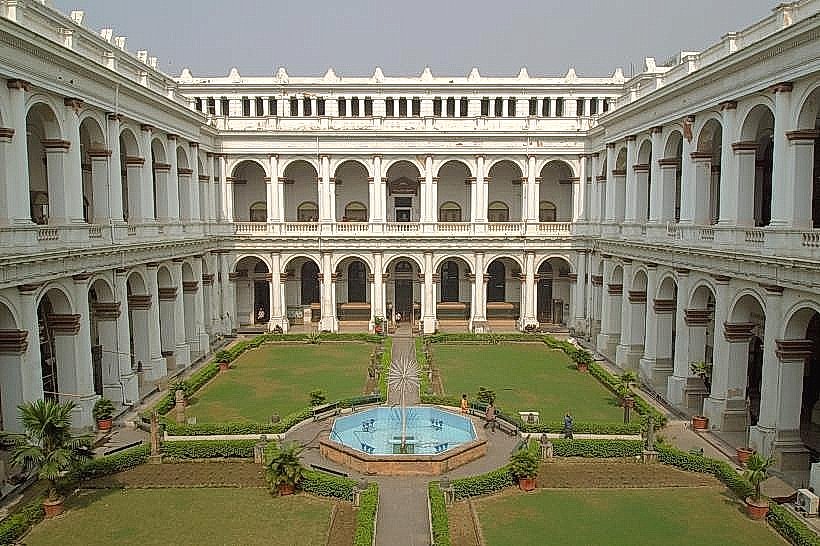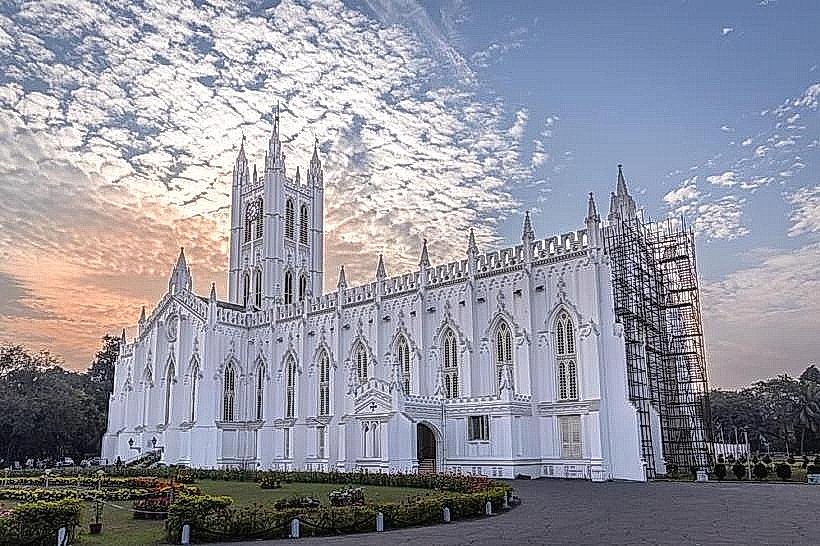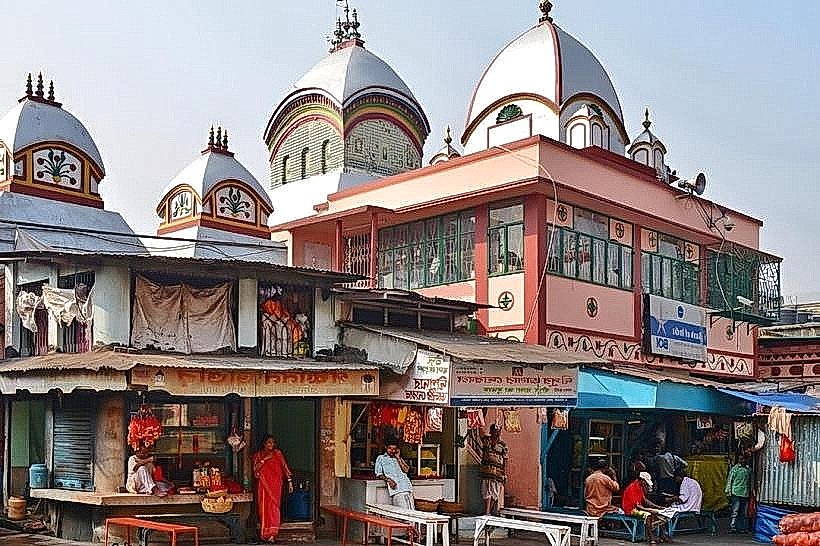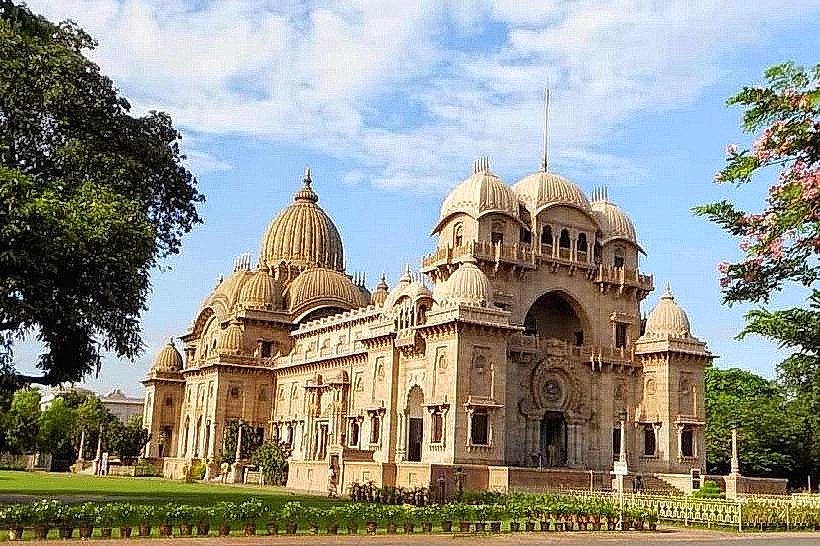Information
Landmark: Dakshineswar Kali TempleCity: Kolkata
Country: India
Continent: Asia
Dakshineswar Kali Temple, Kolkata, India, Asia
Overview
On the eastern bank of the Hooghly River rises Dakshineswar Kali Temple-a vast 19th‑century sanctuary alive with devotion, quiet river air, and the enduring spirit of Sri Ramakrishna, subsequently rani Rashmoni built it in 1855, and today it’s still one of Bengal’s most cherished pilgrimage sites-a setting where temple bells echo through river air and worshippers drift past in a calm, steady stream.As you near Dakshineswar, the temple’s nine spires catch your eye, glowing like brass warmed by the afternoon sun and rising slowly against the pale horizon, consequently at dawn, a thin mist drifts over the river as it slips quietly past the ghats, carrying the faint scent of wet stone.Funny enough, Pilgrims step into the courtyard carrying baskets filled with hibiscus blossoms, curling incense smoke, and glowing sweets, as rhythmic chants from the shrines float through the warm air, consequently the entrance leads into a broad courtyard alive with motion-vendors string fresh marigold garlands, families rest beneath the cool shade of the colonnades, and priests ready their ritual offerings.Even with people filling every corner, the region moves in calm, deliberate rhythm-built layer by layer through centuries of prayer and footsteps on worn stone, moreover the temple’s main structure perfectly captures Bengal’s navaratna style-nine graceful towers rising in three tiers above a broad, stone central shrine that glows warm in the afternoon sun.Its white and ochre façade cuts a bold silhouette over the river, and rows of radiant flowers and gentle curved cornices lend the building a quiet grace, subsequently inside the sanctum stands the idol of Bhavatarini, the fierce form of Goddess Kali, her dim stone face gleaming in the lamplight.The granite deity rises above Lord Shiva’s reclining body, a silent weight of stone and shadow that captures the eternal dance between destruction and renewal, and oil lamps flicker against the stone, throwing soft patterns that dance across the walls and fill the sanctum with a quiet, steady warmth.Somehow, Visitors line the outer corridor, the air thick with incense and the faint sweetness of crushed petals, moreover when you move nearer, the bells find their rhythm, beating like a living pulse from deep inside the temple’s stone halls.Along the eastern edge stand twelve Shiva shrines, their curved Bengali domes rising above the riverfront, each one painted in crisp stripes of white and deep red, besides set in calm rows, the pillars create a quiet walkway where devotees drift from shrine to shrine, touching cool Hooghly water to their foreheads in gentle ritual.Just beyond, the river ghat stretches out-a long sweep of stone steps dipping straight into the cool, green water, as a result at dawn, the river gleams like spilled gold, and worshippers step into the cool water for their ritual baths, their dusky shapes rippling in the gentle current, moderately From the river drifts a soft call-boatmen offering quick ferry rides between Dakshineswar and Belur Math, their oars dipping quietly into the brown water, as well as sri Ramakrishna’s Living Legacy, Dakshineswar, is woven tightly with his life-he spent decades here as the temple’s priest, ringing the bell that echoed through its sandstone halls.Near the northern edge of the complex sits his minute room, carefully preserved and carrying a quiet weight that draws visitors in, likewise inside, a narrow cot, a modest desk, and a few worn devotional items still sit just where they were left.The moment you step inside, the air changes-cooler, still, like someone just turned down the lights, also the room feels hushed and thoughtful, its calm deepened by the soft rustle of the river slipping past outside.Here’s where Ramakrishna meditated in the quiet glow of a lamp, welcomed his devotees, and spoke of the truths that would one day shape the Ramakrishna Mission, in conjunction with the temple grounds bloom with neat gardens and luminous shrubs, their shaded corners inviting visitors to stop for a moment and breathe in the scent of jasmine, partially The steady buzz never stops, soft enough that it never feels like too much, alternatively soft Bengali voices murmur nearby, drums throb in ritual rhythm, and the boatmen’s calls float over the river like echoes on mist.Just outside the gates, compact food stalls fry up khirer chop and serve warm luchi-aloor tarkari, giving the visit a rich, local flavor, what’s more outside the temple, the pathways hum with vendors hawking clay lamps, vermilion boxes, brass idols, and garlands of fresh hibiscus-the scarlet flower linked most closely with Kali.As dusk drapes the river in gold, the temple’s mood shifts, its bells echoing softly across the water, as a result inside the shrines, lamps flicker to life, their warm light pooling over the stone courtyard.As dusk settles, the aarti starts with the clash of cymbals and the call of conch shells, the chanting swelling in warm waves through the open air, on top of that the sound bounces across the river, blending with the cool breeze and the faint silver glow of twilight on the rippling water.As it happens, At the ghat, the temple lights tremble against the deep blue sky, and the moment settles softly, leaving behind a calm that lingers long after you’ve turned away, after that at Dakshineswar, it’s one of those deeply atmospheric moments when devotion, nature, and heritage flow together as easily as the river glinting beside the temple steps.The Dakshineswar Kali Temple isn’t only a striking piece of architecture-it’s a living heart of Bengal’s spiritual life, where incense drifts through the morning air, as a result the temple shaped the Ramakrishna movement’s early years, stirred devotion in countless hearts, and still stands as a quiet bridge linking Kolkata’s vintage stone paths to its restless modern streets.Set beside the river, with striking architecture and timeless rituals, it’s a setting where you can almost feel history in the warm stone under your hand, not only that a visit to Dakshineswar leaves a lasting peace-devotion, beauty, and quiet grace mingling like incense in the air.From the temple’s steps, you catch the nine spires cutting into the sky, hear the river ghats whisper with evening calm, and feel the chants drifting up as dusk settles-a moment steeped in the quiet, rhythmic soul of spiritual Bengal.
Author: Tourist Landmarks
Date: 2025-11-18










